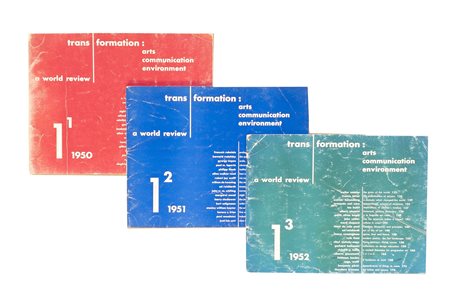 Finarte - Via dei Bossi 2, 20121 Milano
Finarte - Via dei Bossi 2, 20121 Milano
Testimonianze: libri e documenti dell'arte moderna e contemporanea Tornata unica
giovedì 16 luglio 2020 ore 16:30 (UTC +01:00)
Transformation: Arts, Communication, Environment. A world review - Riviste d’arte
Transformation: Arts, Communication, Environment. A world review - Riviste d’arte
nn. 1 - 2 - 3 (tutto il pubblicato)New York, Wittenborn, Schulz, Inc., Publishers, 1950/1952, 3 fascicoli, cm. 21,4x27,8, brossura, pp. 53-(7); 60 (61/120); 56 (121/176)
Redazione e design grafico di Harry Holtzman e Martin James. Rivista di arte, letteratura, cultura sociale, antropologia e scienze. Fascicolo I (1950): 36 illustrazioni in bianco e nero: disegni, immagini fotografiche e riproduzioni di opere realizzate d Naum Gabo, Alexander Calder, Sebastian Matta, Le Corbusier, Ad Reinhardt (“Museum Landscape” con una storia illustrata su due pagine) a altri. Testi di S. I. Hayakawa (“Modern art and 20th century man”), Sigfired Gidion (“Art on the ames demonstration. Art and perception”), Alfred H. Barr, Buckminster Fuller (“Comprehnsive designing”), Allen Walker Read (“The background of the word «semantics»”), Ad Reinhardt (“Museum Landscape” una storia a fumetti su due pagine), Le Corbusier, Piet Mondrian e molti altri. Fascicolo II (1951): 44 illustrazioni in bianco e nero: disegni, immagini fotografiche e riproduzioni di opere realizzate da Gyorgy Kepes, Willem de Koonig, Ad Reinhardt (“Museum racing form” una storia a fumetti su due pagine), René Magritte, Kurt Seligmann, Jan Arp e altri. Testi di: Bernard Rudofsky (“The quiltmakers”), Gyorgy Kepes (“Scale, Structure, Rhythm”), Willem de Koonig (“The Renaissence and order”), Paul Meadows (“Industrialization of social research”) e altri. Fascicolo III (1952): 44 illustrazioni in bianco e nero: disegni, immagini fotografiche e riproduzioni di opere realizzate da Ad Reinhardt (“Art of life of Art” una storia a fumetti su due pagine), Merce Cunningham, Mark Rothko, Jackson Pollock, Alberto Giacometti. testi di: Francis Bitter (“The potentialities of physics”), Leo Balet (“Implications of Einstein’s totalism”), Merce Cunnigham (“Space, time and dance”), Gerhard Kallmann (“Reflections on design education”), Alberto Giacometti (“1+1 = 3”), Benjamin Péret (“Remembrance of things to come”) e altri.
NOTE
“Transformation it was a venue for a wide list of contributors from the areas of the arts and architecture; its fostering of a «holistic» approach to what was then called the «environment» could be thought as anticipating what was going to be fully developed and tested in the still to come «experiments» of the 1960s. While embedded in the art world, trans/formation was devoted neither to art nor to architecture but to a proposition that the arts and the sciences could be brought together in a common enterprise. To that end, the journal solicited contributions from natural and social scientists. Further, in addition to the CIAM contingent, it featured an array of other voices in the arts - Gyorgy Kepes, Buckminster Fuller, Marcel Duchamp, Ad Reinhardt, John Cage, Bernard Rudofsky-representatives of plural modernisms, «alternative» and «avant-garde». Trans/formation therefore encompassed within a single historical object positions that have often been conceived to be communicating along an axis of oppositions: major and minor, central and marginal, dominant and critical.” (Vallye, Anna.“The strategic universality of trans/formation, 1950-1952,” Grey room ,New York, no. 35 Spring 2009: 28-57.).

